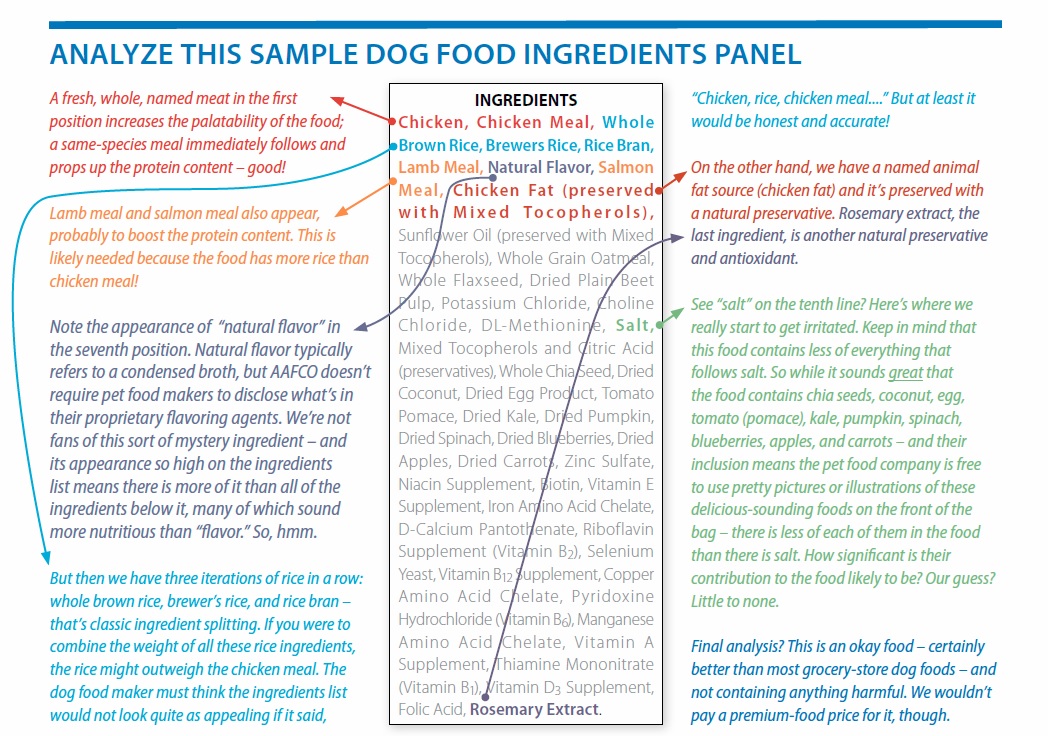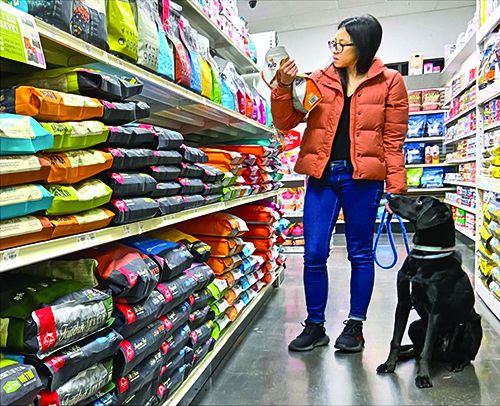Alright! You’re in the pet supply store, armed with information about what you have been feeding your dog. You know which nutritional adequacy (AAFCO) statement to look for, you know how much protein and fat should be in the guaranteed analysis of the foods you are going to consider, and, presumably, you know how much you are willing to spend. Put on your reading glasses or get out your cell phone (so you can use the camera’s zoom): It’s time to read ingredient labels.
NOT SHOPPING FOR YOU
Let’s be clear: You are not looking for something that sounds yummy to eat. Products that contain 20 different food items that you might find in your kitchen (or Martha Stewart’s kitchen, say) cannot possibly contain enough of any of those ingredients to do your dog any good. This sort of ingredient list is meant to appeal to your appetite.
Ingredients are listed according to their weight before the food was processed. By the time you get past the sixth or seventh ingredient on a label, the amount of that ingredient in the food is pretty small, so we’re neither going to get too excited nor too upset about the appearance of one or two particularly healthful or egregious ingredients in eighth place or below.
Note that food-type ingredients (fruits, vegetables, fats, grains, etc.) that appear after or between any added salt or vitamins or minerals are present in the product in inconsequential amounts. No foods are particularly beneficial in these minuscule amounts.
In contrast, potent herbs or supplements, such as turmeric or DHA, may be beneficial in tiny amounts. But the more of these things that appear on the ingredients list, the smaller their amounts are by necessity – and we’re right back to the suspicion that the ingredients list has been built to appeal to you rather than benefit your dog.
HALLMARKS OF QUALITY
Here are the things that you want to see on an ingredients list:
- Lots of named animal protein at the top of the ingredients list. “Named” means the species is identified: chicken, beef, lamb, etc. Unnamed animal sources include “meat” and “poultry.”
When a named meat is first on the ingredient list, there should be a named animal-meal (i.e., chicken meal, lamb meal) immediately or closely following the meat. Meat meals are made by rendering – essentially boiling down, dehydrating, and grinding the animal tissues into a granular, powdery high-protein meal.
Fresh meat contains a lot of moisture (which is heavy), so if meat is first on the list, it acts like a diluted protein source; while it adds an appealing flavor and aroma to the food, it doesn’t actually contribute adequate protein to the diet. That’s why another named source of animal protein should appear in the top two or three ingredients.
- When vegetables, fruits, grains, potatoes, or legumes are used, they should be whole.(as opposed to highly processed fractions that are likely a waste product from the human food industry, such as tomato pomace, brewer’s rice, and soybean mill run).
- Bonus points for products that are made with ingredients that are certified as organic, humanely raised, or sustainably farmed. We understand that it’s good marketing, but we also like to buy from companies who support shelters or rescues, manufacture in “green” plants, and participate in recycling and waste reduction programs.
DISQUALIFIERS
Here are some things to avoid – undesirable attributes that indicate a lower-quality food:
- Unnamed animal protein sources. “Meat,” “meat and bone meal,” and “poultry” are examples of protein sources to avoid.
- Meat by-products, poultry by-products, meat by-product meal, and poultry by-product meal. These ingredients are often handled with far less care than more expensive animal protein sources (i.e., without refrigeration and with less sanitation).
- “Generic” fat sources. “Animal fat” can be any mixed fat of animal origin. “Poultry” fat is not as suspect as “animal fat,” but “chicken fat” or “duck fat” is better (and traceable).
- Novel ingredients. Having access to foods with uncommon ingredients (such as alligator, kangaroo, quail, rabbit, etc., as well as carbohydrate sources like quinoa and amaranth) can be a lifesaver when your dog has multiple proven allergies to common foods and you need to find a diet that contains ingredients he’s never had before.
If you feed these foods to a dog who does not have allergies and he develops allergies later, you will have a diminished pool of candidate novel diets to feed him. Also, less is known about ingredients with short histories of use in pet food. Save these foods until you really need them.
- “Ingredient splitting,” whereby two or more very similar food “fractions” appear on the ingredients list. Because the ingredients are listed in descending order of their weight, a manufacturer can make it appear that a high-quality ingredient is represented in the food in a greater amount than it really is.
This is accomplished by using several fractions or versions of an ingredient as separate ingredients (i.e., rice, brewer’s rice, rice bran, rice protein meal). If all the iterations of that ingredient were combined or reconstituted, they would outweigh the higher-quality ingredient, pushing the better-quality ingredient down on the ingredients list.
- We don’t recommend foods that use animal plasma or blood meal as a protein source. The traceability of the product concerns us.
- Added sweeteners. Sweeteners are used to increase the palatability of foods; they should not be needed to attract a dog to a diet that contains quality animal protein and fat sources and that has been properly cooked and preserved.
- Artificial colors, flavors, or preservatives (such as BHA, BHT, ethoxyquin). Chemical coloring agents are unnecessary; the color of the food doesn’t matter to your dog. Synthetic flavors should not be necessary in a quality food; healthy meats and fats will be enticing enough. Natural preservatives, such as mixed tocopherols, should be used instead of synthetic preservatives.
NOW GO SHOP
We’ve listed dozens of manufacturers who make good dog foods, including foods with grain and without; diets made with fresh meats only, meat meals only, or both; and moderately priced to expensive foods (super cheap foods don’t meet our selection criteria). These are just some of the brands that meet our approval; you may find more.
Keeping your dog’s individual needs in mind, try some new products, switch frequently – and always watch your dog! Note the date that you start feeding any new food on a calendar and record your dog’s physical responses to the switch, good and bad. If you pay attention, he’ll let you know what works for him (and what doesn’t) with his appetite, energy, skin and coat, stool, and weight. Just be ready to adjust his diet as needed.








I just buy a lab. What food can you recommend?